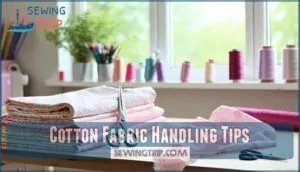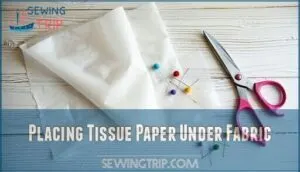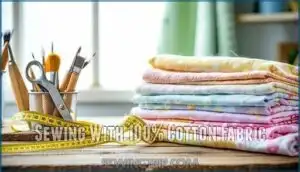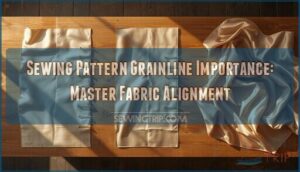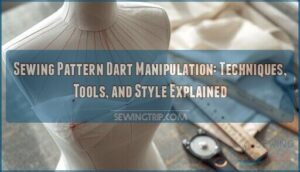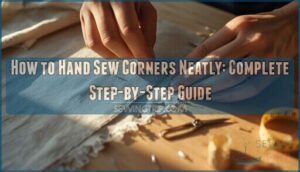This site is supported by our readers. We may earn a commission, at no cost to you, if you purchase through links.
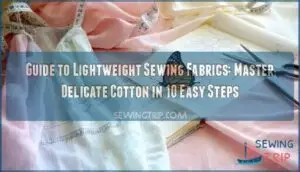 Lightweight fabrics, like voile, batiste, and cotton lawn, are breezy and beautiful but need a little TLC to sew.
Lightweight fabrics, like voile, batiste, and cotton lawn, are breezy and beautiful but need a little TLC to sew.
They can stretch, fray, or distort if you’re not careful, so start by using sharp needles, fine thread, and a straight stitch.
Pre-wash your fabric to avoid surprises later—no one likes a project that shrinks.
Cut carefully along the grain, and consider pinking shears or spray starch to fight fraying.
Patterns with simple seams and rolled hems work best, and you should treat these fabrics like you’d handle a butterfly—gentle and precise.
Stick around; there’s plenty more to learn about mastering these delicate fabrics!
Table Of Contents
- Key Takeaways
- Lightweight Fabric Types
- Sewing Techniques for Lightweight Fabrics
- Handling Delicate Fabrics
- Pattern Considerations for Lightweight Fabrics
- Cotton Fabric Handling Tips
- Sewing Cotton Fabric Successfully
- Cutting Cotton Without Fraying
- Choosing The Right Stitch for Cotton
- Sewing With 100% Cotton Fabric
- Mastering Lightweight Fabric Sewing
- Frequently Asked Questions (FAQs)
- Conclusion
Key Takeaways
- Use fine needles, lightweight thread, and a small stitch length to prevent puckering and distortion when sewing lightweight fabrics.
- Pre-wash and press your fabric to avoid surprises like shrinking or dye runs, and always cut along the grainline for stability.
- Choose patterns with simple seams, loose fits, and minimal embellishments to showcase the fabric’s natural drape.
- Finish edges with techniques like French seams or zigzag stitches to prevent fraying and keep seams neat and durable.
Lightweight Fabric Types

You’ll discover a variety of featherlight fabrics that’ll transform your sewing projects from ordinary to extraordinary, including whisper-thin voile, delicate batiste, textured dotted swiss, and versatile lawn.
Just like choosing between cloud-soft marshmallows and fluffy cotton candy, each lightweight fabric has unique characteristics that make it perfect for specific garments and sewing adventures.
Voile Fabric Characteristics
Voile fabric, the gossamer ballet dancer of the textile world, offers a magical blend of sheerness and structure.
A delicate symphony of sheerness and flow, voile fabric dances gracefully between elegance and practicality in your creative projects.
You’ll love its semi-transparent appearance and delicate drape that flows like water.
This lightweight fabric comes in cotton, silk, or polyester blends, with cotton voile being most popular.
Its fine weave provides breathability for summer garments while maintaining enough body to create beautiful silhouettes.
Voile’s name comes from the French, with the term meaning "veil".
Easy to care for but requires gentle handling!
Batiste Fabric Uses
Batiste fabric steals the show in the category of versatile lightweight fabrics.
You’ll find this semi-sheer wonder perfect for summer baby clothes, lightweight blouses, and delicate undergarments.
Its breathable nature makes it ideal for hot weather garments, while its smooth finish works beautifully as lining for other fabrics.
Crafters love batiste for heirloom sewing projects thanks to its fine weave and gentle drape.
Dotted Swiss Fabric Texture
While batiste serves as the perfect underlining fabric, dotted Swiss offers a completely different texture experience.
Batiste thrives as the delicate foundation, while dotted Swiss dances with playful texture and charm, adding character to any creation.
This charming lightweight fabric features a smooth base with raised dots that give it character and depth.
You’ll love how it drapes beautifully while maintaining its distinctive texture.
The embellished dots can be regular or irregular, single or multi-colored, making each dotted Swiss fabric uniquely appealing for wedding dresses, blouses, and even baby clothes.
Lawn Fabric Properties
While dotted Swiss adds charming texture to your projects, lawn fabric steps up the game with more substance.
Heavier than its lightweight cousins, cotton lawn offers excellent drape while remaining opaque (though light colors might show a hint of sheerness).
You’ll love its durability and fine weave! Liberty Tana lawn sets the gold standard—yes, at a higher cost—but more budget-friendly options give you that same lovely body without emptying your wallet.
Understanding fabric weight (GSM) is essential for selecting the right material for your project, considering factors like substance and opacity.
Sewing Techniques for Lightweight Fabrics
Frequently, the difference between a professional-looking garment and a homemade disaster lies in your sewing techniques for lightweight fabrics.
When working with delicate cotton, always use the smallest needle your sewing machine allows – a size 60/8 or 70/10 works wonders. Pair this with lightweight thread and reduce your tension slightly to prevent puckering.
For seam finishes, French seams or bias binding hide raw edges beautifully while adding minimal bulk. "I once tried regular seams on voile," my instructor laughed, "it looked like a frayed mess after one wash!"
Consider adding hem weights to improve drape on flowing garments. In the area of interfacing choices, opt for featherweight fusible to maintain the fabric’s natural movement.
Remember to switch your machine to a shorter stitch length (1.5-2mm) and practice fabric handling techniques on scraps before diving into your project.
Handling Delicate Fabrics
You’ll find that delicate fabrics have a mind of their own, much like trying to wrangle a slippery fish that’s determined to escape your grasp.
With gentle hands and the right tools, you’ll transform these tricky materials from frustrating foes into cooperative companions that bring your sewing projects to life.
Preventing Fabric Stretching
Now that you’ve learned key sewing techniques, let’s tackle a common headache: fabric stretching.
When working with lightweight fabrics, they’ll wiggle like a fish out of water along the bias-cut edges.
To keep them in line, try stay-stitching tips around curves and apply interfacing solutions where needed.
Always handle fabric with gentle hands, maintaining grainline accuracy by supporting its weight as you sew.
Hemline stabilization with tissue paper can be your secret weapon against unwanted stretch.
Minimizing Fabric Distortion
Now that you’ve got strategies to prevent stretching, let’s tackle fabric distortion – the shape-shifting nemesis of lightweight fabrics.
Handle your delicate cottons with kid gloves to maintain grainline integrity. Support the fabric’s weight evenly during cutting and sewing to prevent bias stretching.
Consider lightweight interfacing options for structure without bulk. Remember: gentle handling makes all the difference when working with these temperamental beauties.
To prevent damage, consider selecting gentle detergents. Your fabric’s not having an identity crisis—it just needs proper stabilization techniques!
Using Sharp Pins and Needles
Precision is your best friend when working with lightweight fabrics. Sharp pins and needles make all the difference between professional results and frustrating tears.
Here’s what you’ll need:
- Extra-fine glass head pins (they glide through delicate fibers like butter)
- Ballpoint needles for stretchy lightweight fabrics
- Sharp microtex needles for woven cottons
- Proper pin placement every 2-3 inches
- Fresh needles (change them after 6-8 hours of sewing)
Consider using specialty glass pins for best results.
Pattern Considerations for Lightweight Fabrics
You’ll need to choose patterns specifically designed for lightweight fabrics, or your beautiful voile might end up looking like a droopy parachute instead of that dreamy summer dress you imagined.
Simple designs with minimal seams and loose-fitting styles will showcase your fabric’s natural drape while making your sewing experience much less like wrestling with tissue paper, utilizing the fabric’s natural drape.
Simple Loose-Fitting Patterns
Now that you understand how delicate fabrics behave, let’s talk pattern selection.
When working with lightweight fabrics, simple loose-fitting patterns are your best friends. The Riley pattern uses less than 2 yards of fabric and has minimal seams that won’t overwork your delicate material.
Beginner projects like A-line tops or flowy skirts provide plenty of pattern ease and comfort focus while showcasing beautiful drape dependence in breathable fabrics perfect for summer sewing.
Avoiding Heavy Trims and Embellishments
Skip the heavyweight embellishments when working with lightweight fabrics.
Bulky buttons, chunky beads, or dense embroidery can destroy fabric integrity faster than scissors through butter.
Instead, opt for lightweight alternatives like delicate lace trim, small seed beads, or subtle detailing that won’t drag down your fabric’s natural drape.
Minimalist design works best here—let the fabric’s movement and texture speak for itself rather than weighing it down, using techniques that preserve the fabric’s natural drape.
Rolled Hems for Delicate Fabrics
While heavy trims can weigh down your delicate creations, rolled hems offer the perfect finishing touch.
These tiny, neat edges are ideal for lightweight fabrics that can’t handle bulky finishes.
You’ll love how a rolled hem preserves the flow and drape of your voile or lawn projects.
Think of it as giving your fabric a whisper-light border that won’t fight against its natural movement, providing a perfect finish with a delicate touch.
Cotton Fabric Handling Tips
Handling cotton fabric doesn’t have to feel like wrestling with a cloud.
With a few smart tricks like pre-washing, cutting along the grainline, and using pinking shears, you’ll keep your project neat and frustration-free.
Pre-Washing and Pressing Cotton
Before sewing, prewashing cotton fabric is your secret weapon.
It tackles shrinkage prevention, softening material, and guarantees wrinkle removal.
Plus, it’s perfect for colorfastness testing—nobody wants surprise dye runs!
After washing, press the fabric flat to lock in its shape.
Fabric preparation like this makes cutting and sewing easier, letting you focus on the fun part: creating!
Cutting Cotton Along The Grainline
When cutting cotton fabric, always align your pattern pieces with the grainline—it’s like following a GPS for fabric stability.
Cutting off-grain risks bias concerns, warping, and uneven seams.
Use sharp scissors for cutting accuracy and to prevent fraying. A little prep work here saves headaches later, so take your time and let the grainline guide you!
Using Pinking Shears to Minimize Fraying
Pinking shears are a handy tool for fraying prevention, but they’re not perfect.
For best results, follow these tips:
- Use on tightly woven fabrics for cleaner edges.
- Pair with a zigzag stitch for extra durability.
- Avoid lightweight fabrics prone to distortion.
- Test on scraps to check pinking shears limitations.
- Explore alternatives like sergers for delicate sewing projects.
To maintain their effectiveness, remember to perform regular cleaning of the blades, which can be learned more about at regular cleaning.
Sewing Cotton Fabric Successfully
Sewing cotton fabric doesn’t have to be tricky if you’ve got the right tools and techniques.
With a good stitch width, the perfect thread, and a trusty straight stitch, you’ll be creating crisp seams in no time!
Choosing The Right Stitch Width
Finding the perfect stitch width depends on fabric weight and your sewing machine settings.
Lightweight cotton? Go for 1.5-2mm.
Medium-weight? Stick to 2-2.5mm.
Too wide, and seams weaken; too narrow, and fabric puckers.
Think of stitch length as Goldilocks—get it just right!
Test on scraps first to avoid surprises.
| Fabric Weight | Stitch Length | Needle Size | Thread Type | Seam Strength |
|---|---|---|---|---|
| Lightweight | 1.5-2mm | 70/10 | Cotton | Delicate but firm |
| Medium-weight | 2-2.5mm | 80/12 | Polyester/Cotton | Balanced |
| Heavy-weight | 3-4mm | 100/16 | Heavy-duty | Strong |
| Extra Heavy | 3-4mm | 120/20 | Upholstery | Extra durable |
| Sheer Fabrics | 1.8-2mm | 60/8 | Fine Silk | Gentle yet secure |
The table provides a quick reference for various fabric types, including Lightweight, Medium-weight, Heavy-weight, Extra Heavy, and Sheer Fabrics, helping you choose the right needle size and thread type for your sewing project.
It’s essential to consider seam strength when selecting your stitch settings to ensure a professional finish.
Selecting The Best Thread for Cotton
When working with cotton fabric, thread choice can make or break your project.
Cotton thread is ideal for its softness and consistency, but polyester adds strength for heavier tasks.
Thread weight matters—use medium-weight for lightweight cotton.
Color matching tips? Go a shade darker for seamless blending.
For superior results, consider using the best thread cotton.
Store threads properly to avoid tangles and dust.
Keep it simple and ensure you have the best thread for your needs.
Using a Straight Stitch for Seams
After picking the right thread, focus on using a straight stitch for seams.
Set your sewing machine to a small stitch length—1.8 to 2.5 mm works well for lightweight cotton.
Adjust thread tension to avoid puckering, and match your needle type to the fabric weight.
Stick to the seam allowance, and finish edges with zigzag stitches for durability.
Cutting Cotton Without Fraying
Cutting cotton without fraying doesn’t have to feel like a battle with loose threads.
With the right tools and a few clever tricks, you’ll keep your fabric edges neat and frustration-free.
Using Fabric Shears or Sharp Scissors
Sharp fabric shears are your best friend for clean cuts and smooth edges. Their shear sharpness guarantees precision, especially with delicate sewing fabric types.
Keep your cutting angles steady for fabric stability. Choose ergonomic shears to save your hands during long projects.
Maintenance matters—keep them sharp and clean. You can find the best fabric shears online. It’s like slicing butter with a hot knife—effortless!
Applying Spray Starch for Stability
Spray starch is your secret weapon for taming lightweight sewing fabrics.
It stiffens slippery material, making cutting and sewing a breeze.
Choose a starch brand suited to your fabric type—some work better for cotton, while others handle blends well.
For a natural alternative, try homemade starch sprays, but remember that overuse can affect long-term fabric softness, so go easy and use it as a breeze!
Placing Tissue Paper Under Fabric
Tissue paper is your secret weapon for cutting stability and fabric support.
Slide a sheet under delicate fabrics to prevent slippage and ease pinning frustrations. It acts like a stabilizer, keeping those tricky, lightweight pieces from shifting.
Plus, it’s cheap and easy to use. Consider using pinking shears after cutting to further mitigate fraying.
Say goodbye to sewing challenges and hello to smoother cuts with this simple sewing tip!
Choosing The Right Stitch for Cotton
Getting the right stitch for cotton can feel like picking the perfect tool from a crowded toolbox—it’s all about matching the stitch to the fabric’s weight.
Don’t worry, though; with a few simple tips, you’ll sew lightweight cotton like a pro without any puckers or frays, and master the technique with ease.
Stitch Width for Lightweight Cotton
When working with lightweight cotton fabrics like cotton lawn, a stitch width of 1.5-2mm on your sewing machine prevents puckering and guarantees smooth seams.
Fabric weight impacts stitch choice, so match it carefully. Thread type matters too—use lightweight cotton thread for better seam strength.
Keep stitch length short for lightweight clothing, facilitating precision without stretching the fabric.
Needle Size for Medium-Weight Cotton
Choosing the right needle size is like picking the perfect tool for the job—it makes all the difference.
For medium-weight cotton:
- Use size 80/12 or 90/14 sewing needles.
- Match the needle point type to the fabric thickness.
- Verify thread compatibility for smooth seams.
- Adjust machine tension for even seam appearance.
Selecting the right needle involves understanding machine sewing needle anatomy. Your cotton sewing guide just got sharper with the right needle size and machine sewing knowledge.
Using a Zigzag Stitch for Finishing
A zigzag stitch is your go-to for seam finishing. It stabilizes fabric edges, prevents fraying, and adds durability.
Adjust the zigzag stitch width and length on your sewing machine to avoid puckering. Pair it with the right thread type for smooth results.
It’s like giving your fabric a safety net! The right settings are crucial for a professional finish.
| Setting | Recommended Value | Impact |
|---|---|---|
| Stitch Width | 2-3mm | Prevents puckering |
| Stitch Length | 1.5-2mm | Smooth seam finish |
| Thread Type | Cotton or Polyester | Reduces fraying |
Sewing With 100% Cotton Fabric
Sewing with 100% cotton fabric is both rewarding and beginner-friendly, making it perfect for projects like summer dresses or cozy quilts.
You’ll love how easy it’s to cut, stitch, and press, but don’t forget to finish those seams to keep fraying at bay, and enjoy the overall process.
Suitable Projects for Lightweight Cotton
Lightweight cotton fabrics like voile, batiste, and lawn are perfect for summer dresses, baby clothes, or quilt backing.
Try sewing lightweight curtains or exploring blouses patterns for breezy options.
These fabrics are also great for small sewing projects like scarves or produce bags, and their airy feel and versatility make them ideal for creating practical yet stylish pieces!
Using Cotton Thread for Delicate Projects
Cotton thread is your best friend for delicate fabrics.
Its fiber properties match lightweight cotton perfectly, offering flexibility and consistency.
Always check thread weight for project suitability and aim for color matching—it’s like accessorizing your garment.
Adjust tension settings to prevent puckering, and don’t rush, as patience and these sewing tips will make your sewing projects shine.
Finishing Seams With a Serger or Zigzag
How do you keep seams neat? Use a serger or zigzag stitch for a polished finish!
Adjust the serger tension and zigzag width for balanced stitch density. Try the differential feed to prevent fabric puckering.
Thread choice matters—use lightweight thread to match your fabric. These sewing tips are perfect for garment sewing, ensuring your fabric stays durable and professional-looking!
Mastering Lightweight Fabric Sewing
Sewing lightweight fabrics can feel like wrestling with a stubborn breeze, but it’s all about using the right techniques.
With some practice, patience, and a few clever tricks, you’ll tame even the trickiest fabrics in no time.
Practicing With Similar Fabrics
Grab those fabric scrap piles and turn them into your playground!
Test seam techniques, experiment with stitch lengths, and tweak tension settings.
Practice on similar fabrics like cotton lawn, linen fabric, rayon challis, voile, or batiste.
Don’t skip needle size trials—it’s like finding the perfect dance partner for your machine.
Mistakes here? No problem!
Seeking Expert Advice for Challenges
When you’re stuck with sewing frustrations like garment construction issues or drape problem solutions, reaching out for expert advice can save you tons of time.
Whether it’s pattern adjustment help, fabric selection guidance, or seam finishing options, an experienced voice offers specialized insights.
Sometimes a fresh perspective on fabric properties and handling tips is all you need to conquer challenges, and getting expert advice can make a significant difference.
Being Patient and Experimenting With Techniques
Mastering lightweight fabrics takes consistent practice and a bit of patience. Starting with fabric scraps lets you test stitch lengths, assess fabric drape, and tweak techniques without the pressure of perfection. Think of it as a sewing warm-up!
- Test trial seams on similar fabrics.
- Explore fabric properties and blends.
- Adjust techniques based on fabric characteristics.
- Embrace iterative sewing—it’s progress, not perfection!
Frequently Asked Questions (FAQs)
What are the different types of lightweight fabric?
Imagine this: fabrics so light they’d float away like a balloon.
You’ve got voile, batiste, dotted swiss, lawn, and gingham.
Each one offers unique textures, drape, and charm, perfect for breezy, delicate sewing projects.
What setting do you set sewing machine for light fabric?
Set your sewing machine to a small stitch length (8-5mm) and light tension (around 3 to 4). Use a fine needle (size 60/8 or 70/10) and lightweight cotton thread.
What tension should I use for lightweight fabric?
Ah, the beauty of sewing finesse!
For lightweight fabrics, aim to set your machine’s tension between 3 to
Test on scrap fabric first—it’s like a dress rehearsal for your masterpiece!
How to sew lightweight fabric?
Use a fine needle, light thread, and a walking foot to prevent slipping.
Handle fabric gently, sew with a small stitch length, and avoid backstitching.
Practice patience—it’s like taming a feisty kitten!
What are the best lightweight fabrics for summer?
Summer’s secret weapon?
Lightweight fabrics like breathable cotton voile, airy linen, cool chambray, and soft batiste.
They’re your ultimate companions—keeping you comfy, stylish, and sweat-free, even when the sun feels like it’s melting everything!
How can lightweight fabrics be maintained after sewing?
Keep lightweight fabrics fresh by hand-washing or using the gentle cycle, cool water, and mild detergent.
Avoid high heat when drying—lay flat or hang.
Press on low heat with a press cloth to avoid scorching.
What lining options suit lightweight, sheer fabrics?
Silky linings protect sheer fabrics while adding elegance.
Lightweight options like silk habotai, cotton voile, or polyester chiffon work wonders.
They prevent transparency, reduce cling, and maintain drape, ensuring your garment stays polished and practical.
How do humidity and temperature affect fabric drape?
Humidity makes fabrics heavier and increases drape, while dry air can stiffen them.
High temperatures loosen fibers, boosting softness and flow.
Lightweight fabrics can act fickle—test drape often to avoid surprises in final garments!
What are common mistakes when sewing lightweight fabrics?
Sewing lightweight fabrics can feel like herding cats—frustratingly slippery.
Don’t skip pre-washing, use sharp tools, or ignore fabric grain.
Avoid heavy pins, backstitching, or rushing, as these stretch, distort, and damage delicate materials.
Conclusion
Imagine sewing a breezy summer dress only to watch it fray before your eyes—but that won’t happen if you follow this guide to lightweight sewing fabrics!
With the right tools, careful prep, and a few expert techniques, you’ll handle delicate fabrics like cotton lawn and voile with ease.
Remember, treat these materials gently and stay patient, as every stitch counts, so take your time, experiment, and enjoy mastering the art of sewing lightweight fabrics!
- http://www.fabricworm.com/annamariahorner.html
- http://www.bandjfabrics.com/servlet/the-Cotton-cln-Liberty-of-London-cln-Tana-Lawn/Categories
- http://www.fabric.com/holiday-hq-holiday-apparel-fabrics-radiance-cotton-silk-poplin-fabric.aspx
- https://www.twinflowercreations.com/pages/fabric-cotton-type-voile?srsltid=AfmBOoq5hjd8C5oS37mIT6_IlGwGbw5Nh51Vfqslw14k-Ry-3famiEsX
- https://brydenapparel.com/voile-fabric/



